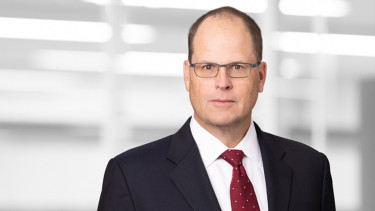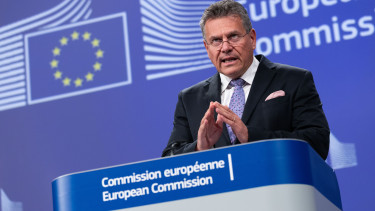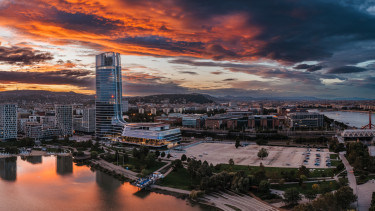Chinese solar power may brighten future for Europe
China has launched in 2016 the idea of transmitting electricity as far as Germany via an ultra-high-voltage direct current (UHVDC) link. This purpose falls under a more comprehensive initiative called “Belt and Road Initiative", which has the ambition to export industrial overcapacity and engineering expertise as it faces slowing growth at home.
But it is the JRC that has delved into the detail of the project. Its comprehensive study reveals that the link could cost anything between EUR 15-16 billion (shortest route) and EUR 23-28 billion (longer routes) depending on the chosen route, how many countries are crossed and if pricey underwater cables are needed. Even cheaper overhead cables come in at roughly EUR 2 million per kilometre.
“Although the idea is currently consigned to the back pages of the report, it raises legitimate questions about how to connect regions rich in clean energy potential to areas of the world that sorely need to cut their reliance on fossil fuels and still meet high energy demands," Euractiv said.
Central Asia is a realm with rich potential in renewable energy sources (RES), mainly wind and solar (but also hydro) which can yield large quantities of “clean" electricity. These are all viable options in many of the countries of Central Asia and thanks to relatively sparse populations, investment in capacity and infrastructure could make the region an energy exporter and go some way to meeting commitments made in the Paris Agreement, the report says.
China intends to exploit its RES from north-eastern regions both for domestic use and for export. The country has the capabilities to project and build long and powerful systems to transmit electricity across the country for thousands of kilometres, it added.
The Mission of China to the EU told Euractiv that “all research work and other kinds of efforts initiated by the European side with the purpose of exploring potential cooperation areas" was welcome.
China continues to build renewable energy capacity in quantities that far outstrip Europe. The Three Gorges Dam across the Yangtze River is still the largest hydroelectric power station in the world and its solar capacity topped 100GW last year, smashing a 2020 target three years early.
Due to the fact the transmission network would cross several time zones regardless of what route would be picked, the JRC’s experts pointed out that it would increase the flexibility of the systems connected to the linkages as peak loads vary depending on local habits and time.
“A long longitudinal-developed power interconnection spread over many time zones could take advantage of the different behavioural rhythms of the population in the meantime optimizing the use of electricity. It would also ease the use of the variable renewables like wind which otherwise would be curtailed when the load or the grid could not take them," the report said. There is a difference of more than 7 hours between Europe CET and China.
Given China’s track record of building massive infrastructure projects, the JRC‘s study assumes that Beijing would be capable of constructing a transmission link that could stretch anything from 5,000 to 8,000 km, the JRC study shows.
Plans are already in motion to connect the northwest of the country with the energy-intensive industrial hubs of the east and urban areas of the south.
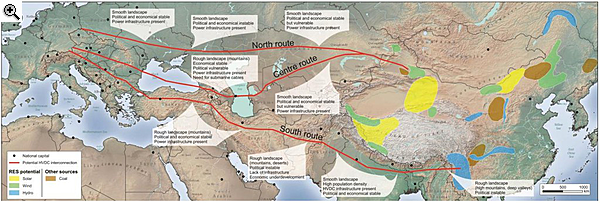
- The north route is the shortest one and crosses the lowest number of countries. It is entirely on land and has no major natural barriers. It crosses parts of Russia and eastern Ukraine.
- The middle route is longer than the previous one and crosses a larger number of countries but with richer potential of RES. It also involves crossing two sea bodies.
- The third route, the southern one, is the longest and crosses the larger number of states. It is entirely on land and crosses several rougher natural environments like mountains, high plateaus and deserts, as well as few conflict areas.
The JRC’s first scenario maps the shortest link, which would start in China’s renewables-rich northwest, before crossing Kazakhstan, Russia and Ukraine. The study cites existing infrastructure that could be upgraded, relatively flat terrain and proximity to Mongolia’s abundant wind energy as big positives.
According to the study, the main advantage of this route is that it can be built as OHL (overhead line) along the entire track, besides the fact that it is the shortest of the three (cc. 5,600 km). “This reduces the number of constructive solutions to be used as well as the number of the converter stations."
The main disadvantages come from traversing of Russia and Ukraine, especially of the eastern part of the latter, presently under military conflicts.
Russia could be uninterested to host on its territory such an infrastructure that competes with its gas transmission network. On the other hand, the line would traverse the country on a short distance, not long enough to capture much of the RES potential (which is not particularly high), or to cover the consumption, given the fact that the crossed region is already well supplied with power from domestic sources through a well-developed infrastructure.
Crossing Ukraine would be advantageous as it shortens the route but drawing its course through eastern Ukraine complicates a lot, at least for the moment and for the foreseeable future, finding a safe solution for the line construction and operation. Diverging the route to avoid the conflict area would lengthen the track through Russia.The JRC’s experts warned that if the link were brought online, it could also be used as a political tool to build dependency if not regulated or managed correctly.
There are also doubts about whether Russia would be interested in granting essential permits given that it would reduce Europe’s need for imported gas, which Moscow continues to use as leverage against Europe, Euractiv noted.The second scenario bypasses Russia and Ukraine by crossing the Caspian and Black seas. This route is longer that the previous one, measuring 6,500 km which requires a lager quantity of material used (conductors, poles) but also would experience higher losses which are proportional with the length of the line.
Its advantage is given by the fact that it traverses more areas that could be exploited for clean energy. It also avoids Russia and the conflict areas in eastern Ukraine. However, the route crosses a larger number of countries which requires more consensuses for finding an optimal economic solution to satisfy all the individual requirements. This also implies a larger number of permits and regulations that must be met. The route also crosses two large sea basins where the transmission mode has to be changed from OHL to submarine cable. This route would go across Hungary in a South-East and North-West direction before reaching the Austrian border.
The third route is quite different, in that it starts in southwest China and makes its way to Europe via Myanmar, India, Pakistan, Afghanistan, Iran and Turkey. It is the longest one out of the three considered with more than 8,600 km with at least 2,000 km longer than the central one and with almost 3,000 km more than the northern one.
This route crosses the Asian continent through its southern expanse, avoiding the bulky mountainous mass and high plateaus in western China. It has several advantages which make it attractive but along the route there are a series of natural and societal limitations which can be surpassed with higher costs.
Despite the significant challenges posed by the terrain the potential to tap into varied sources of clean energy are equally rewarding. The study acknowledges that existing infrastructure west of India is poor at best but suggests that the route would help incorporate those countries, previously thought of as marginal, into the energy transition and boost their economies.
In China the hydropower potential is huge and its exploitation has already begun. The northern mountainous area of Myanmar has a high unused hydropower potential and the same is true for the southern fringes of Himalaya Mountains in India, Nepal and Bhutan. Only in India it is partly exploited.
The main advantages are:- A couple of countries (China and India) have already a solid experience in designing and building HVDC systems, several of them being aligned along the route.
- The high-density population with perspectives of economic improvement in future located along the eastern half of the route.
- The route offers also a real chance for economic integration for regions considered until recently as marginal but which start to play an important strategic role in the equation of the regional RES resources: Myanmar, Afghanistan and Iran.
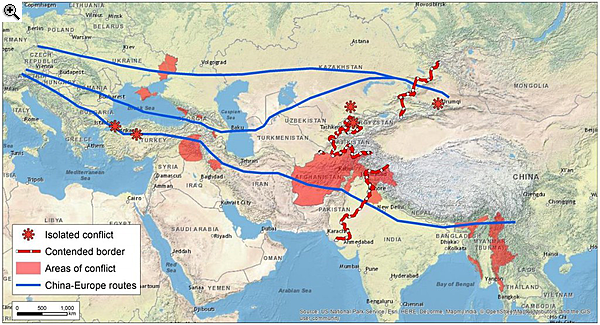
Energy and climate expert Jørgen Knud Henningsen told Euractiv that the idea of a transcontinental cable was an interesting one but explained that linking markets together only makes sense if they are different to one another.
Henningsen, who was senior EU negotiator during the Kyoto Protocol talks, said that both the EU and China will use whatever renewable energy they produce domestically for the foreseeable future, meaning such an expensive export mechanism does not make sense.
Although acknowledging that China could export its clean energy if offered a high enough price in Europe, Henningsen pointed out that Beijing would continue to prioritise linking its renewable energy capacity with industries and cities or even neighbouring countries like Russia or India.
SolarPower Europe, a trade association, said the study was “fascinating", adding that the idea “shows the wide-ranging possibilities for bringing about a clean energy world".
But the trade association also insisted that the EU
must first develop our own internal energy market and make it fit for renewables
and that local power and community energy projects should be the top priority.Negotiators are currently locked in talks on the EU’s renewable energy, energy efficiency and energy governance rules for the 2020-2030 period and will soon start hashing out a reform of the electricity market too.
In the Renewable Energy Directive (RED) negotiations, the European Parliament is hoping to convince the Commission and member states that a 35% non-binding target for 2030 is the best way to boost renewable energy’s share of the energy mix.
But the Council is still backing a 27% figure. The Parliament could potentially rely on the Commission to help fight its corner though as energy and climate Commissioners Maro¹ ©efèoviè and Miguel Arias Cañete have indicated that at least 30% could be affordable, Euractiv said.
The EU executive still officially backs a 27% benchmark, calculated prior to the signing of the Paris Agreement and finalised before the price of renewables began to significantly decrease, but EU sources claim the Commission will raise its level of ambition, backed up by a non-paper circulated in early March.
While the idea of electricity cables stretching from China, possibly through the Himalayas, under seas and across wind-swept steppes may seem far-fetched, there is a precedent for the EU investing in transcontinental links or, at the least, massive infrastructure.
Euractiv reminded that the Nord Stream 2 pipeline between Russia and Germany is steeped in political wrangling but its backers are still pressing on with securing permits and convincing national governments that it is the best solution to the EU’s energy demands.The European Investment Bank (EIB) has also invested billions in the Southern Gas corridor, a massive network of pipelines that is meant to bring gas from the Caspian Sea to Europe. Last week, the EIB approved EUR 932 million of financing for the 1,850-km Trans-Anatolian Pipeline (TANAP) to bring natural gas from Azerbaijan’s Shah Deniz-2 gas field to Europe.
Now that the EU is slowly prioritising electricity connections as the true way to complete its Energy Union and ensure security of supply, including financing an undersea cable between France and Ireland, the idea of linking up with China could eventually gain traction.
“The challenges are immense and, as things stand, might outweigh the benefits. But in a changing world, it could become a reality if the renewable energy revolution keeps going from strength to strength."
Hungary’s role
Conditions for the potential participation of Hungary in the project remain to be worked out, of course. Although the destination of all three routes is Germany, which makes it likely that the Europe’s strongest economy would also play a significant role in the distribution of electricity, such an investment would serve Hungary’s interests too. Two of the possible routes drawn up in the study would go across Hungary, and as a transit country it would probably be part of the development. The additional energy arriving to an European electricity market undergoing integration would also help increase Hungary’s security of supply. Hungary covers about 30% of its power consumption from import. Although the gigantic project is unlikely to help change this ratio for the better, the supply situation would definitely be improved via greater supply and the diversification of sources.Front page photo by MTI/EPA/Francis R. Malasig


